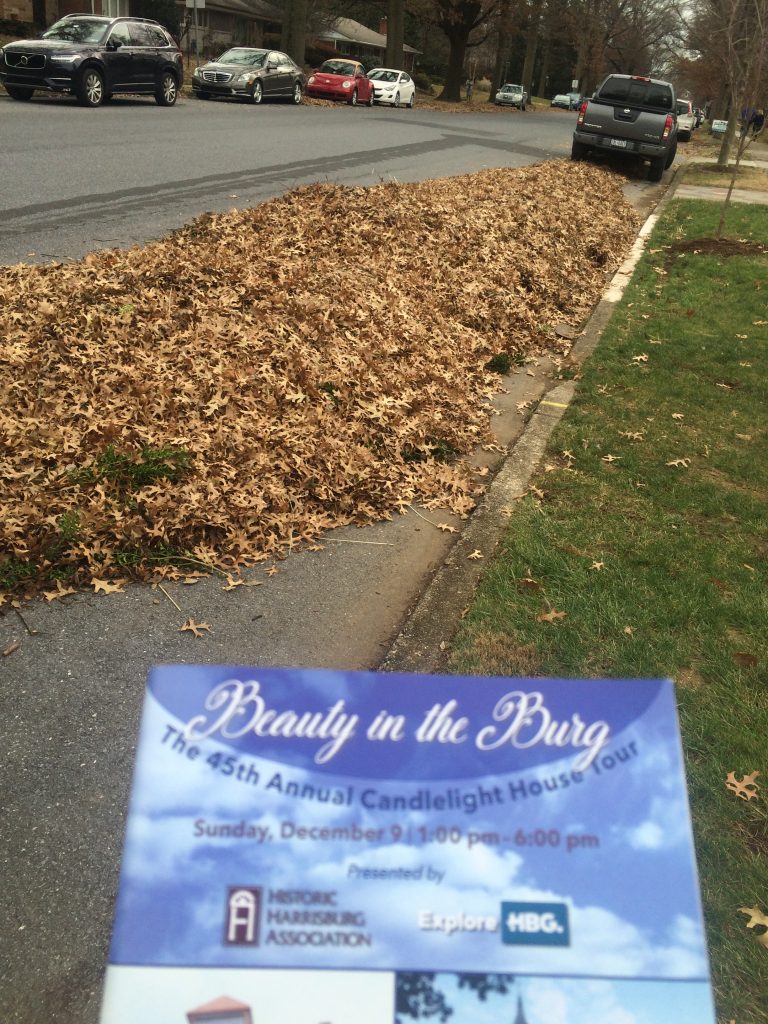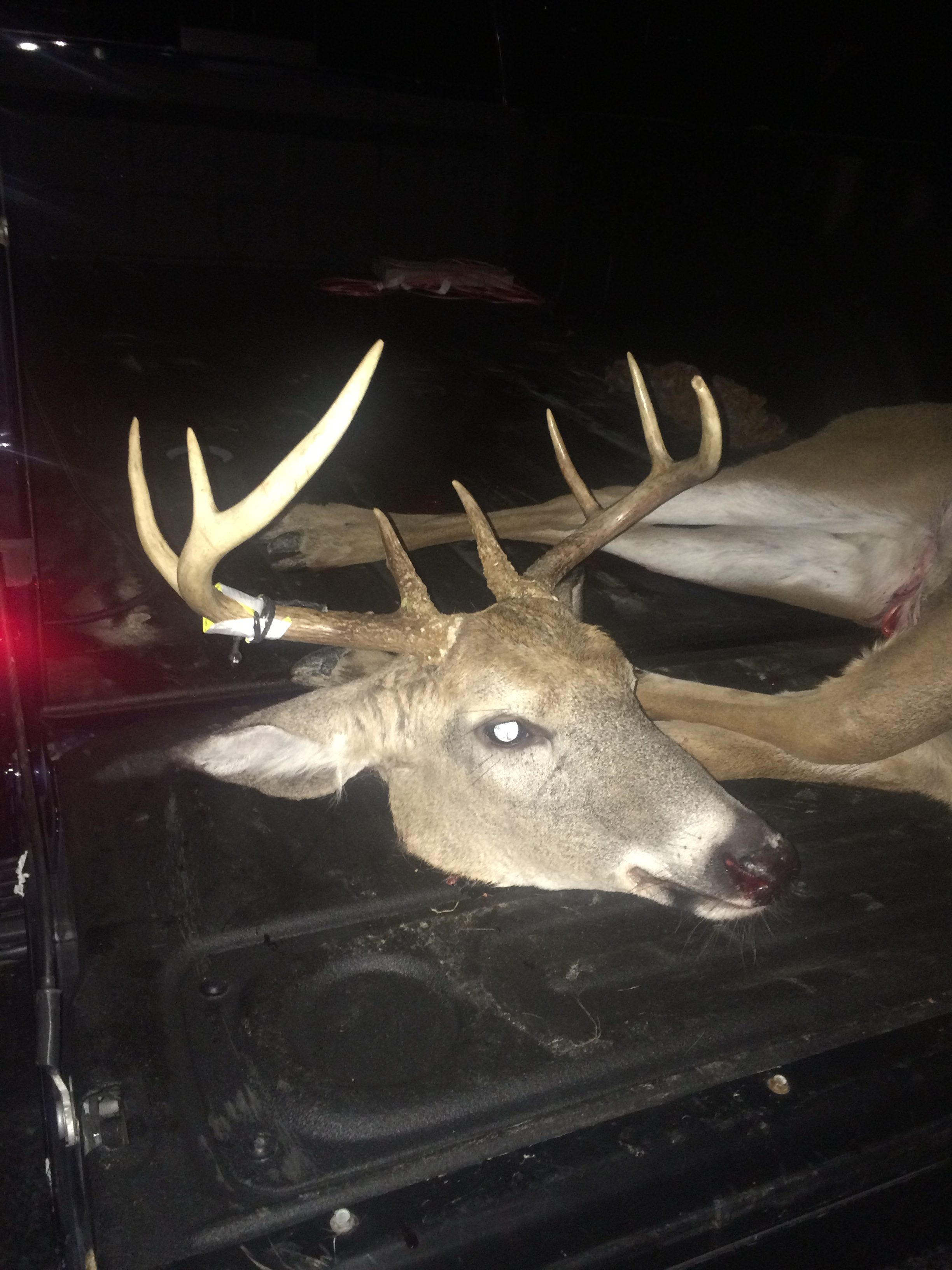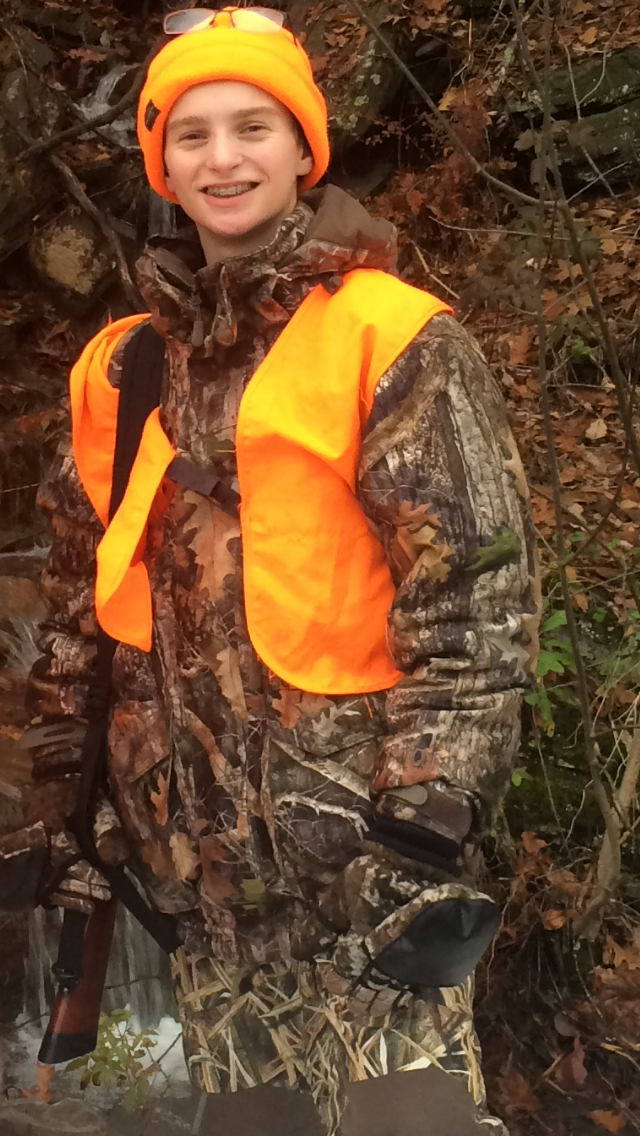Category → Fruit of Contemplation
Science Denier Chuck Todd Declares NBC a Heretic-Free-Zone
In the 1600s, the Catholic Church was on a roll with great momentum. The church’s Great Inquisition was well under way, as a money making venture and as a barbaric instrument of terror, coercing both potentially wayward believers and outright non-believers back into a dark corner, out of fear of physical torture, financial ruin, or burning alive at the stake. Due process and the rule of law were not yet concepts the church embraced outside of a small group of inner circle elitists.
This is the world that early scientists like Galileo and Copernicus stepped into, and where they met with the buzz saw of censorship. This is an old and well-known story from the church’s dark days, and it will not be repeated in detail here. It is mentioned, however, for the benefit of its irony: Today, openly partisan political propagandists like Chuck Todd of NBC “news” have set themselves up as the new church censors, deciding what is truth and what may not be said, for fear of upsetting a political arrangement of things he favors.
Chuck Todd has declared that no heretics will be permitted in his presence. His true goal is to shame and coerce non-believers into submission, out of fear of retribution and ruin.
Like the 1600s church censor before him, Giancito Stefani, the “Master of the Sacred Palace,” Chuck Todd has now declared that no person will be allowed on his NBC television show who defies or questions politically correct dogma, that being human-caused “climate change.”
Not even real scientists who have actually studied climate change are welcome! Really!
Chuck Todd and his coercive brethren today are like the 1630 church fathers; they have the same anti-science goal of control and censorship. In 1630, the church fathers were quite certain that scientists Galileo and Copernicus were way off base, that their ideas were heretical, and that those ideas must be declared haram, off-limits, unwelcome, wrong, banned, and unacceptable. Galileo was to be stopped at any cost. His ideas were dangerous.
To a certain political arrangement of things the church favored.
Similarly, Chuck Todd asserts that climate science is and has been settled, and that is that, he says. It shall not be questioned, he says. Not on his TV show, and, he hopes, not on anyone else’s TV show, either.
Chuck Todd name-calls people who disagree with the idea or claims of human-caused climate change “climate deniers.” This is a fancy name for ‘heretic’. The irony is that Chuck Todd and his co-believers are science deniers, because they deny the scientific refutations of human-caused climate change, and because there is absolutely no science behind the climate change belief Chuck Todd espouses; he and they will permit no actual science to contradict what is essentially a faith belief he and they have.
As if real science is ever settled. The whole point of real science is that it is an ongoing open, transparent enterprise of search and study, curiosity and analysis. Subjects that were once said to be dreamy fairy tales and heresy are today concrete fact.
The problem with human-caused climate science is that it is not transparent, it has been completely politicized, and it is almost 100% built on flawed computer modeling, which is something I know a lot about.
Much of the raw data fed into the computer models has been faked, and the models themselves contain a lot of sloppy methodology (e.g. certain variables are artificially heavily weighted while other variables’ importance are diminished, without any proof of why or how the decision was made).
The East Anglia University scandal is just one example of the complete corruption surrounding climate science.
Recently, Aaron Doering (see his official mugshot below), a purported “climate change expert” professor at the University of Minnesota, was charged with felonious beating the hell out of his girlfriend. Why did this saintly professor strangle his girlfriend? Why, only because she dared to challenge his views. And that right there is the summation of science-denying climate change advocates: Stand them up to scrutiny, and they will lay you down with coercion and violence, because they cannot stand to be challenged or questioned. Bullies, all of them, Doering, Chuck Todd et al.
An example of how established science changes is how the initial dominance of Einstein’s relativity physics resulted in a rejection of later quantum physics. Because for years the two were considered mutually exclusive, and scientists favored Einstein’s physics, which were already well established (the giant mushroom cloud thingy is pretty persuasive Einstein knew what he was talking about). But as quantum physics began to find its way forward with huge particle accelerators that defied what we thought we knew about atomics, Einstein’s relativity physics had to give way. It isn’t that one or the other is proven right or wrong; it is that both appear to be correct and we do not yet know enough about how that can be true, when both are operating on mutually exclusive rules.
So here is Chuck Todd, not a scientist, picking sides in an ongoing scientific debate without any scientific training himself, and without having held a scientific debate to educate his viewers, and using his position to squash dissent and ideas he does not like. This is because he is most loyal to the politics of human-caused climate change. No surprise there, but hey, let’s just say what needs to be said.
A tattered old bumper sticker my friend John Johnson has on his pickup truck says “Liberal ideas: So good they have to be required.”
The flip side of John’s bumper sticker is that totalitarians like Chuck Todd and Aaron Doering are so insecure about the truth of their views that they must censor all contrary arguments. Like almost all others in his establishment media, Chuck Todd bans his critics because he cannot withstand basic scrutiny.
But if the church is any indication, there is hope for Chuck Todd. Fast forward from the bad old days, and the church became an irreplaceable cornerstone of Western Civilization; without its Biblical values, there would be no universal truths or individual rights that make America so great today. The church just had to look inward and answer some basic questions about freedom, liberty, individual conscience, and then everything else fell into place.
And as unjustifiably confident as Chuck Todd is in public, he must have a spark of curiosity buried somewhere in his conscience. A normal person would.
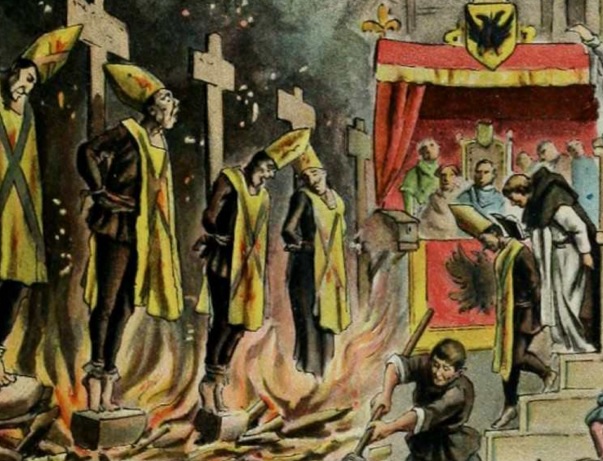
Chuck Todd and Aaron Doering and all other liberals are envious of the Catholic Grand Inquisition’s ability to burn “heretics” alive
Historic Harrisburg Home Tour another great success
Thank you to Historic Harrisburg.
Their annual home tour was once again a lot of fun. We get to walk around in the winter time’s crisp air, with a lot of interesting and friendly people. All of us care about our community, which is important. The homes are always interesting, and many are spectacular. The hosts are always gracious, sometimes with the aid of a glass of wine, or sometimes a bottle or two.
One thing that bears repeating from past posts about these tours is kudos to Alex Hartzler, who has invested in Harrisburg’s re-development for umpteen years. His effort has been as an investor expecting a return, yes, but let’s face it, his WCI Partners faces an uphill task. There is a lot of risk, and the possibility of very little ROI, if any. And yet they go house by house, block by obliterated, abandoned block, and breathe life into Pennsylvania’s capital city.
Another fact worth repeating from previous blog posts here is the important role of gay people, mostly gay men, in gentrification and the slow reclamation of abandoned neighborhoods everywhere, not the least of which are here in Harrisburg.
You have issues with gay people? OK, you are entitled to those feelings, as sexuality really is a private matter. And if your views are Biblical, as are mine, then again, you and I are entitled to our Biblical views on human activity. That said, in my practical observation gay men are an incredible force for economic development and neighborhood renewal, which are good things in my experience and in my view. And they make fantastic, fabulous neighbors. They tend to be neat, kind, friendly, law abiding, all of which are desirable qualities in a neighbor.
In fact, let’s face it, I am downright envious of gay men: They get to spend all their money and time on themselves.
And in that spending process they are helping rebuild Harrisburg into a prosperous and safe community. So I say Thank you, neighbors; I really do not care about your private lifestyle, and I really do appreciate your investment in my neighborhood and community. Everyone have a wonderful holiday season and a successful 2019.
Here are some photos from our tour.

A reclaimed row home in Mid-Town. 100 years ago, these homes were built of strong and attractive materials, with neat designs. These attributes are being re-discovered and appreciated by many Americans seeking close and walking communities.

My “Princess of Patience” in the Levine home in Uptown. What a woman. Until I returned from the mountains, she had been a hunting widow for many weeks.
The Ups and Downs of Pennsylvania’s Status as Trophy Hunting Destination
When I was a kid deer hunting, you would find a comfy seat somewhere under a hemlock or on a stump, and wait for the deer to storm by. The deer would eventually pass by in herds like caribou on the tundra, so many that you often lost count. Almost all were does, which were mostly off limits to hunting back then, and what you were looking for were any signs of antlers. Any flash of white on top of the deer’s head meant it was a buck, and therefore legal for harvest.
No matter how puny, how scrawny, how insignificant the antlers were, “getting your buck” was the goal, and several generations of Pennsylvanians were raised hunting in this low quality atmosphere. Herds of deer far beyond the carrying capacity of the landscape were the norm, as were pathetic excuses for a trophy, usually spike bucks or Y four-pointers, at best.
Fast forward forty years and Pennsylvania is now a true trophy hunting destination. It is unbelievable, really, the incredible successes in wildlife management our state has had. And every one of these achievements has come from outstanding planning by state wildlife biologists over decades.
For example, every year for the past fifteen years we have had bear harvests ranging from 3,000 to 4,000 animals, mostly taken within a three or four-day season. Some of our bears, a fairly high proportion, are gigantic, weighing from 500 to 800 pounds. These are eastern black bears the size of western grizzly bears; but they taste a lot better and they lack the aggressive personality of grizzlies.
Other examples of our wildlife management success are the trapping opportunities for otter, fisher, and bobcat, all of which were exotic, unimaginable, almost alien creatures when I was a kid. Someone you knew had seen one at some point in the woods, but they did not show up in traps, or dead on the roadside. Now? These three charismatic, very cool predators are either common or becoming common across Pennsylvania. There are enough of them to begin to alter prey populations, and forest growth, which means there are surpluses for sportsmen to pursue.
And our wild elk! Other states like Kentucky may have newer, much larger herds of wild elk than Pennsylvania, but they do not have the large human population or oversized road system we have here. Kentucky and the other states that have recently added wild elk can sustain larger herds. Nonetheless, Pennsylvania sees about 100 elk harvested annually, many of which are gigantic trophies on par with the best of western herds.
Finally, the biggest wildlife management success is our deer population. And it is our most controversial.
I have had a good deer season this year. Really, an outstanding deer season, in every way. Quality, quantity, time afield, hunting companionship, family time, scenic and remote places…what a fantastic few weeks it has been. How fortunate am I to have had this time, and it is only possible because Pennsylvania Game Commission biologists have done such an outstanding job of managing our deer populations (Quality Deer Management Association recognized the PGC this year with an award for its incredible deer management).
Here is an example of the controversy surrounding deer hunting here. After sending a photo of one of the deer I took, using a beautiful 1935 German double-barreled rifle made at the peak of German sporting arms engineering, my older friend Jack wrote back to me “If you are not careful, you will clear your mountain of all game.”
In past years Jack has hunted with me at our place and would testify to the high quality deer we have cultivated there. Nonetheless he is anxious about harvesting “too many” deer.
And right there in his statement is the rub, the issue, the friction in our wildlife management here, overshadowing all other successes. Older generations tend to see does as sacred cows, off limits to harvest, whereas the younger generations tend to view deer management through the lens of biology, mathematics, and both habitat and social carrying capacity.
Never mind the other species listed above, just the high quality deer hunting alone makes Pennsylvania a true trophy hunting destination. People are now harvesting gigantic bucks unimaginable fifteen years ago, and that are big enough to hold their own against the long-time trophy deer hunting states like Kansas, Iowa, Illinois and Ohio. Pennsylvania’s deer management is working incredibly well, giving hunters a quality-over-quantity choice that works for today’s hunters and that rankles older generations used to “more is better.”
Deer hunting has gotten so good that, despite much stronger anti poaching laws, people are still going nuts trying to illegally hog up trophy bucks, afraid that if they do not get it, someone else will. Not too many years ago a fine young game warden was gunned down by a night poacher who was determined not to go back to jail (he did). Last week two 57-year-old men were caught shooting at deer from ATVs, and their reaction was to badly beat the deputy game warden and take his gun. They, too, are now in jail.
Older Pennsylvanians seem slow to catch on to our new status as a trophy destination. They act as if does must still be protected (they need not), and as if there are only a couple trophy bucks that must be poached before “someone else steals my buck.” In his recent book To Conserve and Protect: Memories of a Wildlife Conservation Officer, retired game warden Steve Hower recounts some of his experiences dealing with this backwards mindset.
Past PGC executive director Vern Ross used to say at every opportunity he had “Now, today, is the golden age of hunting in Pennsylvania!” Vern was correct then, and even more so now, as hunting opportunities are even better than when he was at PGC.
At some point the vast majority of our hunters will recognize and appreciate what an incredible thing we have now, right now, and instead of complaining about it, they will enjoy it and do what they can too support the PGC.
Some photos below from our bear and deer seasons; the buck photos are from the five minutes I was there on the second night of rifle season at Blue Mountain Deer Processing in Enola, PA. Just look at those incredible heads and huge steer-like bodies! Wow. Unthinkable not too long ago.
“Think those are big? You should have seen the huge ones that poured in here yesterday, on Opening Day,” said Dean Deimler, owner of Blue Mountain Deer Processing.
I have heard of several 160-inch and bigger racks being taken in the mountains, where too many people say “there ain’t no deer.” Like a lot of people, I would rather have a shot at a lifetime trophy buck of 160 inches than see a zillion scrawny spikes and forkhorns.
The young man is my son, who climbed high and steep right along with the adults, handling his firearms expertly and safely, himself taking three deer in two states this season and hunting bear as an adult for the first time. And that is the other ‘trophy’ from deer hunting…watching that next generation grow into an activity as old and as natural as our species.
Best time of the year
November through January is the best time of the year.
“It’s Christmas in November, December AND January,” say my fellow outdoorsmen.
From small game in late October to archery for deer, to the current bear season and then rifle season for deer next week, and then trapping season, it’s nonstop action.
With the nonstop political drama and annoying ankle biting behavior of certain partisans representing themselves as news reporters, we can all use a break. I have been enjoying a break. Friends and family hanging out together, eating together, hunting together, and then hanging out again in comfy relaxation, it’s really an unusually best time of the year.
Under no other circumstances can or will so many people take off from work, drive long distances, and see old friends, as we do now. Maybe a big high school reunion will draw in a lot of disparate people from far and wide. But we do this hunting bit every year.
Santa brought us snow early. The better to hunt and track in. The better to hover around a warm fire from. Thank you, Jolly old Chris Cringle!
Everyone enjoy your winter!
Why California burns
Year after year, Americans are treated to images from California of flaming cars and zillion-dollar homes either burning down to the ground or sliding down canyon walls like toboggans on ski slopes.
No, these images are not from Hollywood movie sets designed to create fake images. These are the real thing, a hell on earth environment does in fact happen as badly on the ground each time we see it from afar.
Why these fires happen is right now subject to some debate, which does not make sense, because their explanation is very easy to understand.
No, President Trump did not cause these fires because his administration’s budget cut the fat off of some bloated California line item cost passed on to Americans everywhere. What a silly thing to say; it is just more “Trump did it!” goofball politics stuff.
No, “climate change” did not somehow cause these fires or the damage resulting from them. That would be impossible. Again, this is just silly politics stuff.
And no, sorry President Trump, these fires are not necessarily happening because California is mismanaging the forests there. That accusation would be correct for a lot of other Western areas, like Colorado, but I am sure that it does not apply to Malibu, California.
It is a fact that much of California’s landscape is a fire-based ecosystem, where wildfires are a constant, expected, and necessary part of the area’s natural cycles. Not only do the plants and trees there burn easily, some of them actually require fire in order for their seeds to germinate. For example, both redwoods and sequoias, two hugely famous trees that grow along California’s coast, have pine cones that will not open unless they are subject to fire. Without fire, these two tree species will not naturally regenerate. They evolved in a fire-based ecosystem.
Humans have built widely in this natural wildfire zone, by choice and with a lot of fore-warning about what they can expect while living there. So it is a mystery why the humans there then run about wringing their hands and trying to blame politicians whenever there is a wildfire that burns down their poorly placed buildings. Serious wildfire is one of the few things they can actually expect to experience at least once a year, every year.
Additionally, the soils along the California coast are the absolute worst types of soil for building on. These are crumbly, loose soils that move around easily, often following gravity downward and carrying whatever humans have built on them along for the ride.
Think about it this way: New York City is famously built on bedrock, a great feature for standing still on a solid base when humans have invested billions of dollars on skyscraper buildings above. Coastal California soils are the exact opposite of New York City’s bed rock.
According to the U.S. Geological Survey, “[these] soils are on side slopes of hills and mountains. These soils formed in residuum and colluvium derived from inter-bedded shale and sandstone. Slopes are 4 to 75 percent.”
What this sciency lingo means is that these soils are loose and easily eroded. Moreover, fire temporarily reduces plants holding the soil together, and then water carries the especially but temporarily loose soil to the ocean. This is natural, it is how this area was created. Building on it is foolish.
A dear friend of mine owns a wonderful vacant lot in the heart of Malibu. Her large tract overlooks the Pacific Ocean and is surrounded by very expensive futuristic homes. Despite this lot’s beauty, she hasn’t built on it yet, because it has been washed away several times and burned at least once. One night we were looking for her corner survey stakes, and we found them down the street. About two feet of soil had washed away in that rain storm; it was mass wasting, really. A home there would have gone along down the street.
Which begs the question: Why would people build homes in a wildfire-dependent ecosystem and on soils that are as slippery as wet soap and as solid as sand?
Well, there is another question, too, which is why are all those expensive homes built on the San Andreas fault? But we can’t answer that until The Big One rocks California to the bone (and we get to see if Californians have an ounce of self-reliance left).
More important, something is going on with the people who live in California. This ‘something‘ is not good, because they are living in a self-imposed fantasy land that does not want them to live there; it is trying to burn them out and flush their buildings into the Pacific Ocean. The people there know what to expect, and yet they do the wrong thing anyhow, over and over.
Watching them now trying to blame President Trump for their own poor judgment would be funny, except the political consequences are serious.
California: Beautiful place, fascinating geology and ecology.
Californians: Bad character, poor judgment, American taxpayer welfare queens.
UPDATE: A friend commented and pointed out that New Orleans is built below sea level next to the seashore, and that Miami is built on a sand bar in the direct path of most hurricanes, and that Phoenix, Arizona, is built in an arid desert with no water anywhere around. These are all similar examples of humans tempting fate and defying Mother Nature. Good luck with that. And yes, I do feel badly for the people who have been directly affected by the most recent fire around Malibu, Paradise, and other California locations. How could I not feel bad for them? It is a sad situation. But the message of this post is that humans cannot successfully defy Mother Nature. It just never ends well for either party, but unlike the humans, Mother Nature can almost always fix herself. Humans need better development planning.
Scoring cheap political points actually costs more than you and I can afford
Trying to score cheap political points seems attractive, because it looks cheap and low-cost. A lot of it has been going on lately, but it actually has a huge cost. It has a huge cost to everyone else as collateral damage victims, and in a just world it should have a boomerang cost on its progenitors.
Scoring cheap political points usually means ascribing blame or responsibility for something the object or person in actuality bears no responsibility for. In other words, it is cheap because it is wrong and unfair.
Over the past two years, attempt after attempt has been made by the mainstream media, and its one political party ally, to ascribe and pin onto Donald Trump responsibility for everything from bad breath to Muslim terrorism to dog bites to you-name-it, they have alleged it.
Most recently, cheap political points were attempted on Judge Kavanaugh, who was at first accused at the 11th hour of his nomination of having momentarily rough-housed as a teenager, 35 years ago, with a female classmate (Blasey Ford). From that one foggy accusation, foggy because Blasey Ford could not recall the date, the day, the time, or the place, and the people she called as witnesses all strongly disagreed with her, came a cascade of increasingly outlandish accusations. Suddenly on TV and news outlets everywhere, Kavanaugh was claimed by various activists and “news” personalities to have been a rapist, a serial rapist, and finally guilty of perjury.
None of this made any sense when squared up with the actual personal history of Judge Kavanaugh. No evidence was ever presented for any of it; it was all just hype and hysteria. It was just a cheap attempt to create a black cloud over Kavanaugh, over Donald Trump, because he nominated Kavanaugh, and over the GOP, because they controlled his future as a nominee. Now he is Justice Kavanaugh on the US Supreme Court, because none of the outlandish cheap political points added up to anything, and the American People didn’t buy the hype.
In that process, the Democrat Party leadership was almost universally revealed to be shameless whores, partisans willing to say and do anything to try to move the public opinion needle more into their favor. Even if it involved destroying the public’s faith in the carefully constructed political system that defines our unique nation.
Then there was the fake “attempted bombing” of a dozen leading Democrats and their financial supporters. Fake because none of the “bombs” were actually functional bombs. None exploded, and as far as we can tell from the information released, none of them could explode. The “bombs” were so outlandishly fake, and the whole effort was so outlandishly amateurish, and the facts were not in, and yet the Democrat Party again began trying to immediately blame Donald Trump, with some people actually saying that Trump ordered the bombs to be sent. Meanwhile, many Americans actually began blaming the Democrat Party for once again ham-handedly trying to gin up false sympathy for their increasingly tarnished brand, to move the public opinion needle in their favor.
And now there is something truly horrendous, a massacre yesterday, in Pittsburgh, Pennsylvania, of eleven elderly synagogue members simply praying to God and harming no one. A deranged lunatic anti-Trump Democrat walked in, screamed “All Jews must die,” and began shooting people.
Within hours, some leftwing Jewish organizations and individuals went into overdrive, using the innocent victims to try to score cheap political points against Donald Trump, the GOP, law-abiding American gun owners, Christians, and just about everyone else they disagree with on some political point or another. Some actually accused Trump of having created an atmosphere and environment conducive and even productive for this sort of attack, which is beyond over-reach. It is simply the same old hysteria we saw with the Kavanaugh smear and the fake bombs, except now resting on the backs of murdered Jewish people.
Out of this latest attempt at cheap political points, the most egregious example is the public statement from the very, very mis-named “Pennsylvania Jewish Coalition.”
There is zero about this group that is a coalition, as coalitions are generally made up of various different parts of groups or philosophies. The PJC represents the farthest left view and political aspirations that can be found in the American Jewish community. More than anything, this is a group of hardcore Bolsheviks; liberal Jews at war with free speech, democracy, capitalism, the US Constitution, lawful private gun ownership. Pretty much everything good that America is or has been, the PJC denigrates.
So, as one might expect, the Pennsylvania Jewish Coalition statement on the Pittsburgh massacre tries to score cheap political points on gun owners and border security advocates, especially, and yet is so shrill and inflammatory that it crosses over into recklessness, because it is sure to paint all Jews with the same insane brush. Thereby inviting more pushback against all Jews.
Naturally, normal Americans are both horrified at the massacre and bristling with indignation that they had anything to do with it. By using the typical crybully tactic and attacking normal Americans and ascribing blame for the massacre to them and their favored politician, Donald Trump, groups like the PJC are alienating the very people they need to persuade. But, like the Democrat Party leaders, the PJC is willing to burn down their own broader community’s credibility in the pursuit of cheap political points.
Election Day, November 6th, cannot come soon enough. If God is just, it will be a day of reckoning and justice for the kooks that are intent on burning down America because they don’t control it.
It is time for normal Americans, the so-called swing voters, the Independents (and how I wish I could register as an Independent), to take note of who is really pushing America to the brink. To take note of who is really up-ending our otherwise calm and happy nation. To pay back in like political currency those who have refused to accept the legitimate results of November 2016, and who have sought to destroy America because they cannot control her.
I rarely advocate for voting straight party ticket, and I rarely do it myself. But this year, a big Republican win over the insane voices and destructive forces from the Democrat Left is necessary to demonstrate that there is a God, and that there is retribution for having used and abused the American People so badly.
Vote straight Republican, even if you never do it again in your life. Now is the time, this is the year.
A few local signs that the economy is smokin’ hot
Me: “Hi. I would like to have Cleon make me log arch, one that I can hook to my ATV, that is stronger than the Chinese junk being sold everywhere, and that is less expensive than the crazy-priced LogRite arches.”
Lynette: “Josh, what is your time frame?”
Me: “Well, I can use it in a week, but two or three weeks is no problem.”
Lynette: “Here’s the thing about timing. Back in June, we were about to lay off one of the welders, but we put out bids on ten jobs, any one or two of which would have carried us through the year. And between last week and this Monday we heard back that we won every single one of them. So we will not only be retaining that junior welder, but we are now looking for about five more to help us meet our commitments. We might not be able to get to your log arch for a while, but one of the men will call you back later today.”
And then one of the men did call me back, with terms and a price that more or less said “If we are going to make this for you, then you are going to pay big for taking us away from our real work.”
Another sign that our local and regional economy is smokin’ hot: The log trucks, the pallet trucks, the lumber trucks on the roads EVERYWHERE and at all times of day.
Never before have I seen so much activity in just one business sector, as I am seeing now in the timber industry, except maybe in 2008 when the Marcellus Shale boom was indeed booming across Pennsylvania.
Log trucks are especially visible. How can you miss a log truck? It dwarfs every other vehicle around it, and looks incredibly incongruous. Log trucks have these huge wide open bays or bunks to hold the logs, and a boom arm with a claw for lifting up 6,000 to 10,000-pound logs. A log truck has about 5,000 board feet or more of medium to high grade logs of all types on it, heading from someone’s private forest to someone else’s mill. From there the logs will be carefully analyzed for grade, and either sold-on or sawn up on site. Hardwood lumber is used in flooring, cabinetry, and furniture, all of which when active indicate a strong consumer and home building economy. Even tulip poplar, once sold for pennies per board foot, is now used for couch frames and cabinetry frames.
At every timber job there are expensive machines at work, with drivers who earn enough money to support a family. And the loggers, guys born with a chainsaw in one hand and a rifle in the other, they cut down a dangerous tree every ten minutes, then lop it and move on to the next before choking up the logs and skidding them to a landing.
Then there is the landowner, who gets good money for something they did absolutely nothing to create.
The sawmills, whether small Amish mills or huge international mills selling hundreds of thousands of board feet per week, are beehives of activity. Every person working there is earning money, and spending money, and contributing toward the larger economic activity around them.
Say nothing of the new homes and kitchen cabinets being built, or of the beautiful hardwood flooring and furniture being made for those new homes. All from someone’s private forest.
The point is, these are just two small examples of how the economy is exploding, and how after many years of stagnation we finally get to do more than scratch out a living, but actually do well and pay for our kids’ questionable college “education,” buy new cars, take nice vacations, and set something aside for our later years, when we are no longer able to work so hard.
It really is a new day in America, and boy does it feel good. One gets the impression that this good feeling is widespread across America, with the sad exception of places in North Carolina and Florida, recently hit hard by hurricanes, and our hearts go out to the victims there. The one thing they can rest assured about is that the materials needed to rebuild their lives are on their way as I write these words, and they are America-made, and America-grown.
A rock from the basement of time
Norman McClean wrote his book “A River Runs Through It,” about his childhood in southwest Montana. Growing up hunting and fishing brought him into close contact with unusual examples of natural history in the field, including really neat geological samples.
Those rocks that he found were what his Presbyterian minister father called “rocks from the basement of time.” Meaning that they were very old, from the beginning of the world. McClean effectively connects his reader with the sense that while standing in a trout river in Montana, holding one of these ancient rocks, he was transported, and the reader along with him, into a kind of time machine and also a giant web of life and history.
This phrase “rocks from the basement of time” always stuck with me, as it is so illustrative of how such basic, simple, everyday things in our lives can yet be so important or significant. And inspiring.
Here below is one such rock from the basement of time, but from this northcentral Pennsylvania corner of the world’s basement. 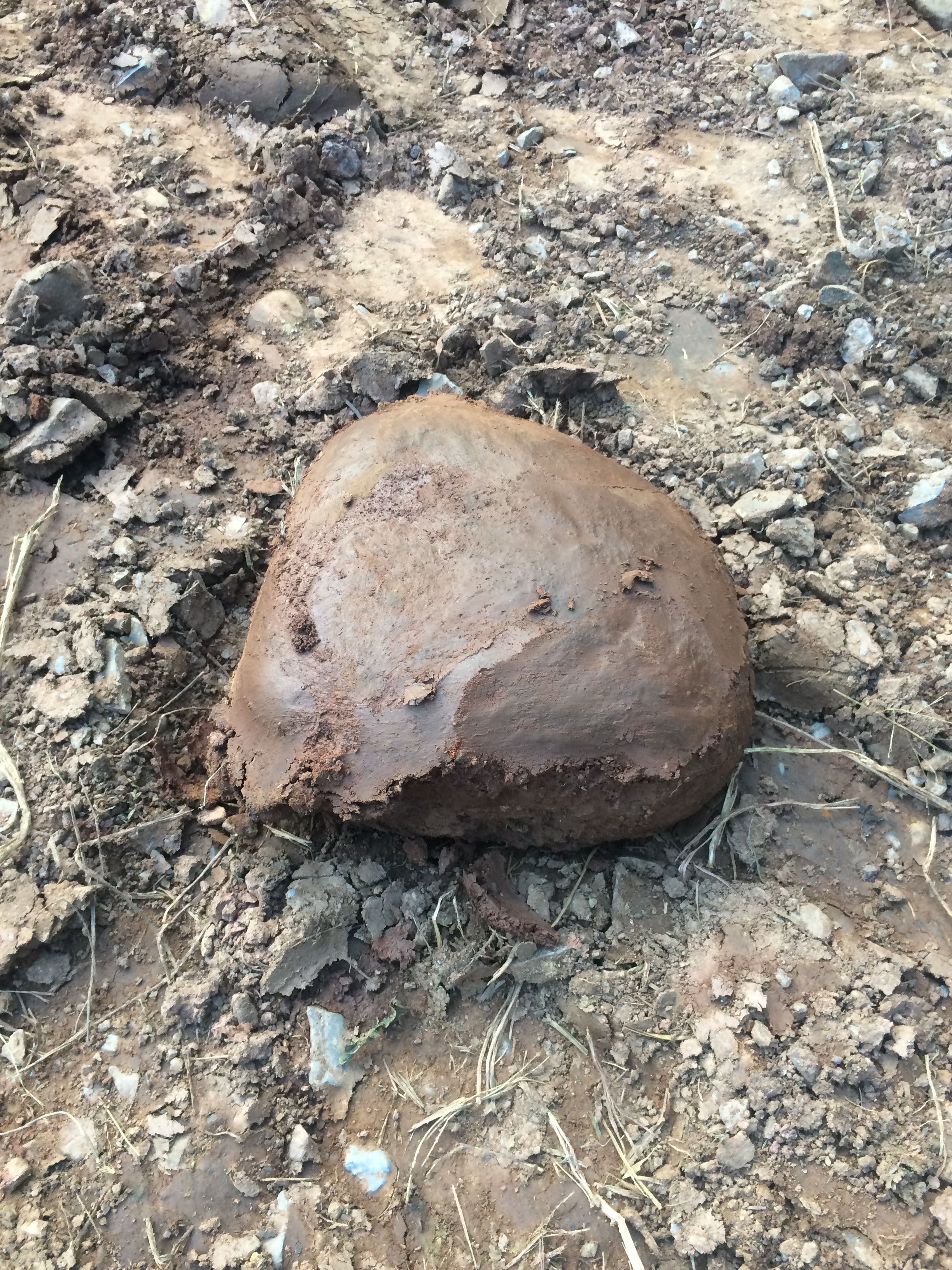
This large, rounded river cobble was unearthed today in the dirt bank behind the cabin in Pine Creek Valley, about four hundred feet above the Pine Creek riverbed. This rounded river stone started out as a squared chunk of slate hundreds of millions of years ago, and was then gently rounded and sculpted by flowing water, and sediment and rocks being pushed downstream over who knows how long. Its most recent path in its long life had it deposited in the great flood that created Pine Creek as we know it today, 10,000 years ago, after the most recent ice age.
At the end of that last ice age, a huge ice dam in the Finger Lakes region melted and burst, pouring an entire inland sea down through the little creek bed that was then north-flowing Pine Creek. All that water flooding the river channel caused Pine Creek to reverse its flow, and in that process enormous amounts of both shattered rock and rounded riverbottom cobble churned its way south, settling out along the walls of the canyon, eventually far far above, almost impossibly above, the new river channel and bed.
When I think about that raging torrent of mud and rock from a hundred miles upstream, filling up the valley’s river hundreds of feet higher than its usual height, and depositing ancient large river stones far above their natural resting place, I think “Wow.”
And here at my feet is all of that incredible story, told in one pretty much otherwise unremarkable rock from the dirt bank behind the cabin. Which I now look at and think of as being part of the basement of time. And suddenly I feel totally differently about my life and everything in it.
Tractor Supply Co. as model of “How Not to do Customer Relations”
All it takes is that little symbol of fouled customer relations to sour someone on a place, and <poof> the customer is gone.
Tractor Supply did that with style.
When I bought the steel pipe shackle months ago, I had a suspicion it was the wrong size. But being at the Tractor Supply Store here in Harrisburg, I purchased it along with the multitude of other stuff.
When it turned out to be the wrong size, I returned with receipt in hand, and brother, did I get a lesson in bad customer service.
The Tractor Supply store manager was rude, aggressive, angry. The cashier lady was lost in space, clueless, dreamy, unhelpful.
They would only issue an $8.00 refund if I gave them my credit card, my name, my address, etc. In other words, they wanted my data. No cash refund, and the receipt was no good without a credit card.
Did you know that Tractor Supply is not a Better Business Bureau member?
How many big retailers are not BBB accredited? Very very few. It is hard to take a retailer seriously unless they are BBB accredited, because it means that the retailer holds themselves to a standard of accountability that customers across America have come to expect.
Well, that is not Tractor Supply’s standard. My BBB complaint was processed and overtures to Tractor Supply by BBB went unheeded, with no response. No satisfaction.
So I called Tractor Supply’s main number in Tennessee, their “Customer Solutions Center,” 877-718-6750.
What a joke that is. No one to speak with on any line or option, no customer service. Every option ends at “please visit our website,” or “please contact your credit card provider.” Tractor Supply provides zero opportunities to speak to any human being, much less a customer service representative.
Tractor Supply lost me as a customer. If they cannot belong to the BBB and guarantee their customers that they can expect professional and honest service, then they do not deserve my money.
If you go to Tractor Supply’s website, you will be treated to a long list of high values and ethics stuff they say they live by. Don’t believe it. It is there for show, as they showed me.
Thank you to wildlife’s friends, my friends
When I started writing for Eric Epstein’s Rock the Capitol about eight years ago, one of the first stories I related to readers was an experience two of my children and I had with two pitbulls let off their leashes.
The readership statistics on this one essay were off the charts. Very high volume, and lots of comments. When I asked why, Eric and his website manager, whose name I now forget, told me that news items and stories involving animals claim the biggest share of attention on the Internet.
Fascinating, right?
And we all kind of see this fact in the strange way people routinely show concern for an injured goat in the news by donating a million dollars so the goat can get its broken hoof fixed, and then a truly sad situation involving some news story about a poor unfortunate child whose abusive parents tormented her for years raises just five bucks to get her into a better home.
It is true that people care about animals, and that is a good thing. But this care seems to extend mostly, really overwhelmingly, to domesticated animals; animals that depend upon humans for care and shelter. A natural and healthy empathy is aroused when some unfortunate critter is seen hemmed in by wire or caging, unable to provide for itself and yet not being provided for by the humans around it.
The type of animals people have the least identity with is wildlife. Most Americans, being urban or suburban, simply mythologize wildlife.
From this more urban view, all bears are universally perceived as aggressively dangerous (they are not, though grizzlies are definitely more aggressive than black bears). Deer run out in front of our cars, eat our crops, spread ticks with Lyme Disease, and nibble our yard shrubs, dammit. Squirrels are nasty tree rats with fuzzy tails chewing on our yard furniture, eating the produce of our gardens and fruit trees, and diving our trash bins. And skunks, possums and raccoons are a bunch of rabies-ridden trashcan raiders. And so on.
Wildlife by and large is not greatly appreciated by the general public, unless it is a close-up photo of some baby raccoon or fox kit. And no, I am not talking about wildlife photographers or the insane Humane Society as representative of the general public. These two categories of people are far distant outliers of one sort or another, and no generality can be drawn from their presence among or about wildlife.
So thank God there are sportsmen out there; that is, hunters and trappers. These are the Americans who really do truly care for and about wildlife, and they prove it every damned day with their financial donations and back-breaking work on wildlife habitat projects.
There is no better advocacy group or aggregation of active people who love wild animals and the wild places they need to thrive than hunters and trappers. Time has proven this fact, though the foolish flatlander will claim, with a mouthful of gross stockyard beef in her mouth, that hunting and trapping are “cruel.”
Most of our public lands were first acquired by and for hunting and trapping, at the urging of hunters and trappers. They knew in the 1890s and 1920s that human encroachment into formerly wild areas was leaving no room for the most interesting animals on earth. Many of these animals are more interesting than most of the humans we will encounter in any given day, week, month, or lifetime.
This weekend I really enjoyed my time among a special group of people, the state-wide leadership of the Pennsylvania Federation of Sportsmen and Conservationists (PFSC), what until yesterday was known as the Pennsylvania Federation of Sportsmen’s Clubs (PFSC). Most Americans no longer know that the word “sport” is about hunting, fishing, and trapping, nor do they know what a ‘sporting club’ is about. The lexicon has changed as the daily experience has changed. Meat is no longer acquired from a wild animal who knew it was hunted, but rather from a miserable creature tormented from its earliest days until its last moment alive and turned into a convenient styrofoam package.
The PFSC folks are the people who work every day for the benefit of wildlife, for wildlife habitat, for the defense and promotion of our state parks, state forests, and state game lands. These people do it humbly, quietly, generously, and usually all they get in return is some self-satisfaction from sitting back after a grouse hunt and, despite an empty game bag, intently watching a mysterious red Fall sunset streaked with white wispy trailing clouds sinking down behind shadowy trees shedding their colorful leaves. A deeply comforting stillness overtakes these people at these moments, alone or with companions, and when they go home that night, they know their decades of work fundraising for the latest land acquisition by the Wildlands Conservancy has paid off. It might be a relatively small nook in a big world, but it is a special nook nonetheless, where wildlife — wild animals unknown and unloved by most people — can call home until the next glacier comes through and re-orders the earth’s surface, as has already happened many times in the past.
Here is to you, a heartfelt thank you, my friends, my companions, my betters and my teachers among the outdoorsman fellowship. Thank you for your time and gift to me and to everyone and every living thing around me, whether they know or know not what you do for us.


